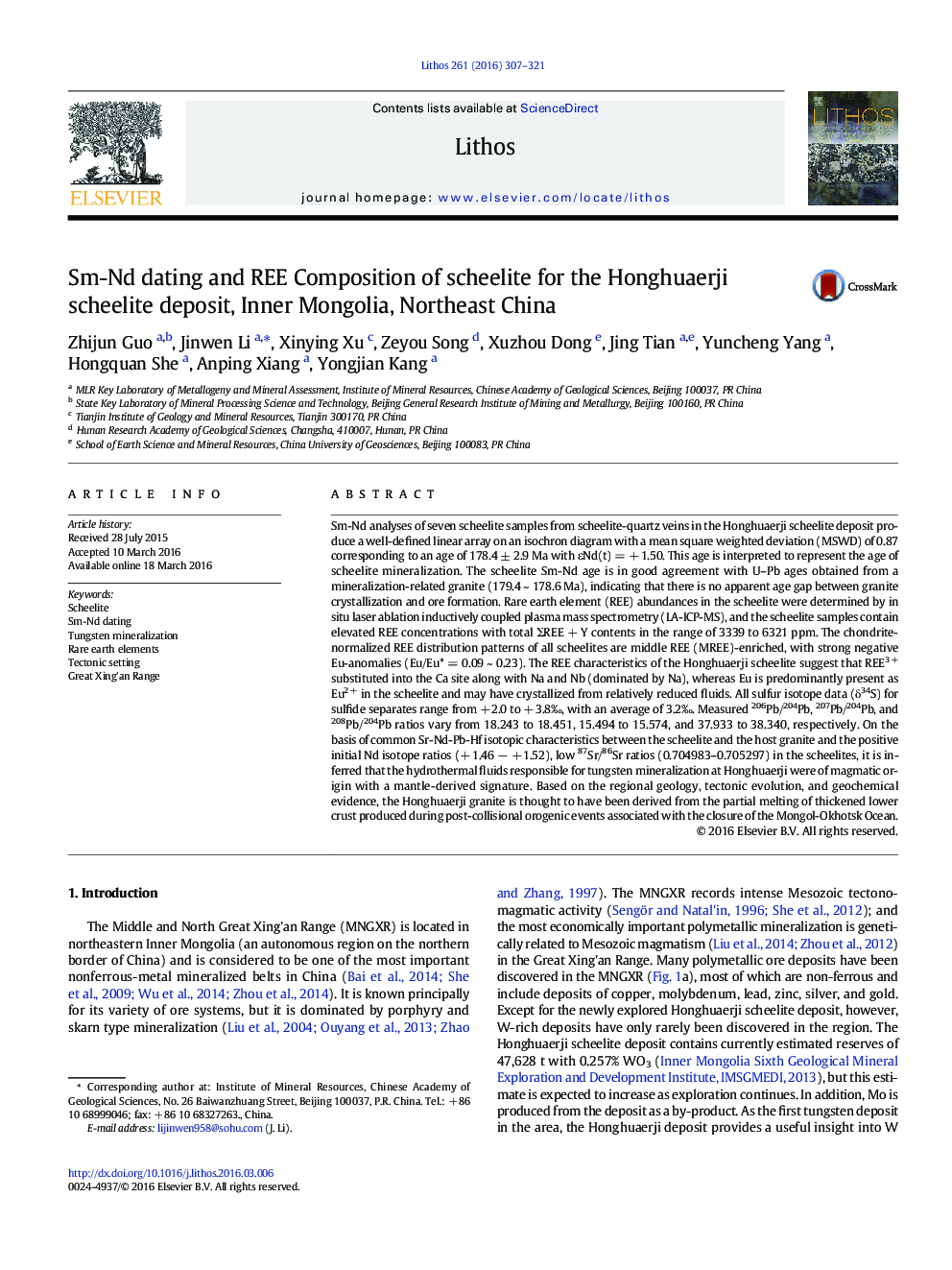| کد مقاله | کد نشریه | سال انتشار | مقاله انگلیسی | نسخه تمام متن |
|---|---|---|---|---|
| 4715562 | 1638643 | 2016 | 15 صفحه PDF | دانلود رایگان |

• Scheelite Sm-Nd dating results indicate that the Honghuaerji deposit formed at 178.4 ± 2.9 Ma.
• The fluid responsible for W mineralization is of magmatic in origin, and mantle-derived signature.
• Chondrite-normalized REE distribution patterns of all scheelites are middle REE-enriched, with a strong negative Eu-anomaly.
• The REE3 + substituted into the Ca site of scheelite coupled with Na and Nb, while the scheelite contain Eu as Eu2 +.
• Honghuaerji deposit was formed in post-collisional tectonic setting caused by closure of the Mongol-Okhotsk Ocean.
Sm-Nd analyses of seven scheelite samples from scheelite-quartz veins in the Honghuaerji scheelite deposit produce a well-defined linear array on an isochron diagram with a mean square weighted deviation (MSWD) of 0.87 corresponding to an age of 178.4 ± 2.9 Ma with εNd(t) = + 1.50. This age is interpreted to represent the age of scheelite mineralization. The scheelite Sm-Nd age is in good agreement with U–Pb ages obtained from a mineralization-related granite (179.4 ~ 178.6 Ma), indicating that there is no apparent age gap between granite crystallization and ore formation. Rare earth element (REE) abundances in the scheelite were determined by in situ laser ablation inductively coupled plasma mass spectrometry (LA-ICP-MS), and the scheelite samples contain elevated REE concentrations with total ΣREE + Y contents in the range of 3339 to 6321 ppm. The chondrite-normalized REE distribution patterns of all scheelites are middle REE (MREE)-enriched, with strong negative Eu-anomalies (Eu/Eu* = 0.09 ~ 0.23). The REE characteristics of the Honghuaerji scheelite suggest that REE3 + substituted into the Ca site along with Na and Nb (dominated by Na), whereas Eu is predominantly present as Eu2 + in the scheelite and may have crystallized from relatively reduced fluids. All sulfur isotope data (δ34S) for sulfide separates range from + 2.0 to + 3.8‰, with an average of 3.2‰. Measured 206Pb/204Pb, 207Pb/204Pb, and 208Pb/204Pb ratios vary from 18.243 to 18.451, 15.494 to 15.574, and 37.933 to 38.340, respectively. On the basis of common Sr-Nd-Pb-Hf isotopic characteristics between the scheelite and the host granite and the positive initial Nd isotope ratios (+ 1.46 − + 1.52), low 87Sr/86Sr ratios (0.704983–0.705297) in the scheelites, it is inferred that the hydrothermal fluids responsible for tungsten mineralization at Honghuaerji were of magmatic origin with a mantle-derived signature. Based on the regional geology, tectonic evolution, and geochemical evidence, the Honghuaerji granite is thought to have been derived from the partial melting of thickened lower crust produced during post-collisional orogenic events associated with the closure of the Mongol-Okhotsk Ocean.
Journal: Lithos - Volume 261, 15 September 2016, Pages 307–321